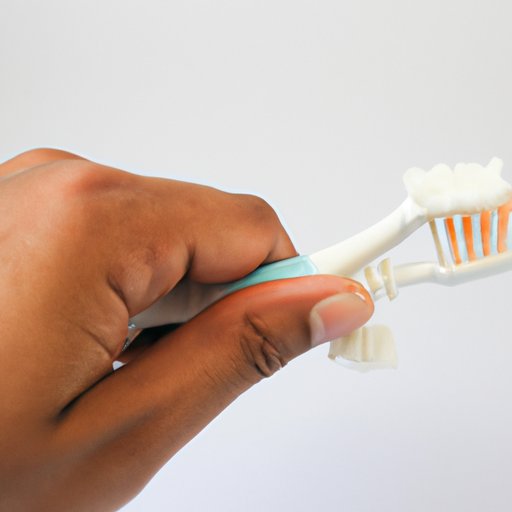
Introduction
When it comes to oral hygiene, many of us focus heavily on brushing our teeth and using mouthwash. However, we often forget that our toothbrush also requires proper cleaning and maintenance. After all, your toothbrush’s job is to remove bacteria and food particles from your mouth. So, it’s essential to keep it free from germs and other harmful elements. In this article, we’re going to explore how to clean a toothbrush, natural ways to sterilize it, and how to keep it clean while traveling.
How to Deep Clean Your Toothbrush: A Step-by-Step Guide
It’s incredibly important to clean your toothbrush regularly to keep it free from bacteria and other germs that can cause oral health issues. Fortunately, deep cleaning your toothbrush is very simple and can be done with items that you have at home. Here’s a step-by-step guide to help you deep clean your toothbrush.
Take your toothbrush and run it under hot water for a few seconds to remove any food particles or debris.
Next, apply a small drop of dish soap to your toothbrush bristles. Gently massage the bristles to create lather, keeping in mind not to damage the bristles. Rinse the brush thoroughly under hot water.
If you want to make sure your toothbrush is free from germs, place it in a cup with white vinegar and baking soda for up to a few hours. Then rinse thoroughly with hot water and let it dry. This is an excellent way to eliminate bacteria and germs from your toothbrush.
5 Natural Ways to Sterilize Your Toothbrush at Home
If you are looking for more natural ways to clean your toothbrush, there are plenty of options available. Here are five different methods that use natural ingredients to disinfect your toothbrush.
• Hydrogen Peroxide – Soak your toothbrush head in hydrogen peroxide for a few minutes to kill bacteria.
• Tea Tree Oil – Mix water and tea tree oil and soak your toothbrush bristles for 10 to 15 minutes. Rinse thoroughly.
• Salt Water – Soak your toothbrush in a solution consisting of salt and water for a few hours to kill off germs and bacteria. Rinse thoroughly.
• Aloe Vera – Mix aloe vera gel and water and soak your toothbrush in it for 10 to 15 minutes. Rinse thoroughly.
• Baking Soda – Mix baking soda and water to create a paste, apply to your toothbrush, and leave for 10 to 15 minutes. Rinse thoroughly.
The Dos and Don’ts of Cleaning Your Toothbrush
If you want to keep your toothbrush clean and free from germs, it’s essential to follow best practices. Here are some dos and don’ts to consider.
DO:
• Rinse your toothbrush thoroughly under water after each use.
• Replace your brush head or toothbrush every three to four months or when the bristles look frayed.
• Use a soft-bristled brush to avoid damaging the bristles or your teeth.
DON’T:
• Share your toothbrush with anyone.
• Store your wet toothbrush in a closed container – it can promote the growth of bacteria.
• Use your toothbrush beyond its expiration date – old, worn-out bristles can do more harm than good.
How Often Should You Replace Your Toothbrush and Why?
Even if you take proper care of your toothbrush, it’s essential to know when to replace it. The general rule of thumb is to replace it every three to four months. However, if you have been sick, it’s recommended to replace your toothbrush after you’re better to avoid reinfection. Worn-out bristles can cause damage to your gums, teeth, and tongue. So, replacing your toothbrush regularly is vital to maintain good oral health.
3 Common Mistakes You Might Be Making While Brushing Your Teeth and How to Avoid Them
While it’s essential to keep your toothbrush clean, it’s equally important to use it correctly. Here are three common mistakes people make while brushing their teeth.
1. Brushing too hard: Brushing your teeth too hard can cause damage to your teeth and gums. Use gentle, circular motions when brushing, and don’t apply too much pressure.
2. Not brushing long enough: Two minutes may seem short, but it’s essential to spend this time brushing your teeth to remove any food particles and bacteria. Set a timer or use an electric toothbrush with an automatic timer to guide you.
3. Not brushing every surface: Make sure to brush each side of your teeth, as well as the front and back surfaces, and your tongue to remove bacteria thoroughly and promote good oral hygiene.
The Truth About UV Toothbrush Sanitizers: Do They Really Work?
UV toothbrush sanitizers claim to kill 99.9% of bacteria and germs commonly found on toothbrushes. However, research shows that these claims are not entirely reliable. While UV sanitizers can reduce bacteria on toothbrushes, they do not prevent bacteria growth on the brush and cannot reach between bristles. It’s essential to clean your toothbrush using one of the methods discussed above to ensure it’s free from bacteria and germs.
How to Keep Your Toothbrush Clean While Traveling
It’s crucial to maintain good oral hygiene, even when you’re away from home. Here are some things you can do to keep your toothbrush clean while traveling.
• Pack a toothbrush holder to protect your brush from germs and bacteria.
• Consider using disposable toothbrushes that come with toothpaste already on them.
• Avoid keeping your toothbrush on the bathroom counter – there may be germs present from other travelers.
Conclusion
Keeping your toothbrush clean is essential to promote good oral hygiene. With these top tips and tricks, you can rest assured that your brush is free from germs and bacteria. Just remember to deep clean your brush regularly, replace it every three to four months, and avoid sharing it with others. Follow these guidelines and enjoy a healthier, cleaner mouth.





